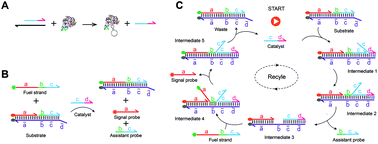An off/on thrombin activated energy driven molecular machine for sensitive detection of human thrombin via non-enzymatic catalyst recycling amplification†
Abstract
In this article, we report a novel dual on/off thrombin fluorescence aptasensor by combining the energy driven target induced strand displacement reaction and a non-enzyme catalyst recycling DNA machine. Firstly, the specific binding of an aptamer strand and thrombin induce the release of a catalyst which was used as a DNA machine trigger. Subsequently, the catalyst as the trigger initiated the DNA machine through nucleic acid hybridization and branch migration of the DNA machine, resulting in the DNA substrate melting and re-hybridization. In such a working model, the DNA machine achieved cooperative control of the circular strand displacement reaction, realizing catalyst recycling and dual-amplification. The fluorescence signal change of FAM and ROX accumulation had a good linear relationship with the thrombin concentration in the range of 1 fM to 1 nM. On account of catalyst recycling and dual recognition, the detection limit for thrombin was determined to be as low as 0.45 fM (S/N = 3).This biosensor also showed good selectivity for thrombin without being affected by some other proteins, such as PSA, lysozyme etc. Moreover, this assay can be applied to the detection of thrombin in diluted human serum.



 Please wait while we load your content...
Please wait while we load your content...